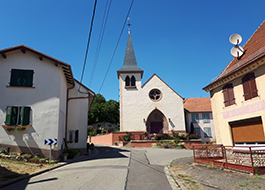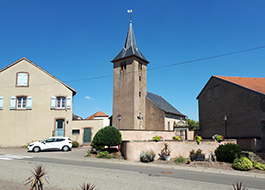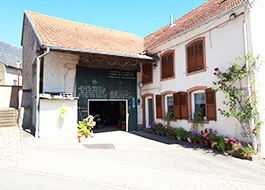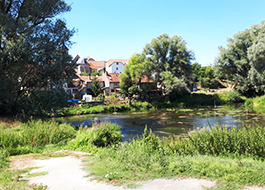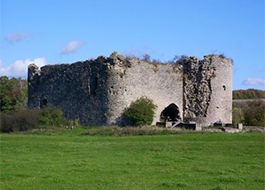Niederstinzel
Durée visite : 60 minutes
Moyen : Pédestre
Stinzel signifie la petite maison en pierre. C’était le nom d’un château-fort, attesté vers 1050, commandant la seigneurie homonyme. Acquis par Jean de Geroldseck au XIVe siècle, le château et la seigneurie en prirent le nom. Les barons de Fénétrange en rachetèrent une part. Ils favorisèrent la Réforme, instaurée à Stinzel en 1565. En 1884, la commune a vu naître le chimiste Georges Imbert. Après 1918, il essaie de transformer du charbon en carburant liquide. Il réussit même à fabriquer de l’essence synthétique, hélas trop coûteuse. Il abandonne la solution du carburant liquide, puis’intéresse aux générateurs à gaz. En 1921, Imbert construit un gazogène à charbon de bois. En 1923, il réussit la gazéification destinée à un véhicule. Il travaille avec De Dietrich de Reichshoffen, puis crée sa société à Sarre-Union. Pendant la guerre, l’Allemagne utilise le gazogène à bois dans les opérations militaires sur des chars, des automitrailleuses et des camions de transport de munitions. À son soixantième anniversaire, pour les services rendus, le Reich le décore. En 1945, ses biens sont mis sous séquestre. Il meurt cinq ans plus tard ruiné.
Stinzel means the little stone house. It was the name of a castle, attested around 1050, commanding the lordship of the same name. Acquired by Jean de Geroldseck in the 14th century, the castle and the lordship took its name. The barons of Fenerange bought a share of it. They favoured the Reformation, established in Stinzel in 1565. In 1884, the town was born the chemist Georges Imbert. After 1918, he tried to turn coal into liquid fuel. He even managed to make synthetic gasoline, which unfortunately was too expensive. He abandoned the liquid fuel solution and then bedated to gas generators. In 1921, Imbert built a charcoal gase. In 1923, he successfully gasified a vehicle. He worked with De Dietrich of Reichshoffen, then set up his company in Saarland-Union. During the war, Germany used wood gas in military operations on tanks, machine guns and ammunition trucks. On his 60th birthday, for the services rendered, the Reich decorated him. In 1945, his assets were placed in receivership. He died five years later ruined.
Stinzel bedeutet das kleine Steinhaus. Es war der Name einer Burg, bezeugt um 1050, Kommandant der gleichnamigen Lordschaft. Von Johannes von Geroldseck im 14. Jahrhundert erworben, nahmen das Schloss und die Herrschaft den Namen an. Die Barone von Fénétrange kauften einen Teil davon zurück. Sie förderten die Reformation, die 1565 in Stinzel eingeführt wurde. 1884 wurde in der Gemeinde der Chemiker Georges Imbert geboren. Nach 1918 versucht er, Kohle in flüssigen Kraftstoff umzuwandeln. Er schafft es sogar, synthetisches Benzin herzustellen, das leider zu teuer ist. Er gibt die Lösung des flüssigen Treibstoffs auf und interessiert sich dann für die Gasgeneratoren. 1921 baute Imbert ein Holzkohlegast. 1923 gelang ihm die Vergasung für ein Fahrzeug. Er arbeitet mit De Dietrich aus Reichshoffen und gründete seine Firma im Saarland-Union. Während des Krieges benutzte Deutschland Holzgasgase bei militärischen Operationen auf Panzern, Selbstmittänern und Munitionstransportwagen. An seinem 60. Geburtstag schmückt ihn das Reich für seine Dienste. 1945 wurde sein Vermögen beschlagnahmt. Er stirbt fünf Jahre später ruiniert.

D’argent semé de billettes d’azur, au chapé du même.
Ce sont les armes des Fénétrange-Géroldseck, seigneurs du lieu, auxquelles on a ajouté un chapé, emblème de saint Martin, patron de la paroisse.
Money strewn with azure logs, in the cloak of the same.
These are the weapons of the Fen strange-Géroldseck, lords of the place, to which was added a chapé, emblem of Saint Martin, patron saint of the parish.
Silber mit blauen Käppchen gesägt, mit dem gleichen Hut.
Dies sind die Waffen der Fénétrange-Geroldseck, die Herren des Ortes, denen ein Chapé hinzugefügt wurde, das Emblem des hl. Martin, des Patrons der Pfarrei.

Les habitants de Niederstinzel s’appellent les Niederstinzellois et les Niderstinzelloises.
The inhabitants of Niederstinzel are called Niederstinzellois and Niederstinzelloises..
Die Einwohner von Niederstinzel heißen die Niederstinzellois und die Niederstinzelloises.
Les points de visites
.
La Réforme fut introduite par les seigneurs de Fénétrange à partir de 1565. Avec son pasteur, la communauté occupa l’église, construite en 1619. En 1685, elle dut la rendre aux catholiques. Au cours du XIXe siècle, la situation religieuse du village bi-confessionnel se stabilisa. L’annexion apporta une seconde école protestante, où l’on tint désormais les cultes. En 1895, le village comptait 258 catholiques pour 285 protestants et un juif. Faute de moyens et à cause de la guerre, une église propre aux luthériens ne se fit pas. En 1934, ils firent enfin construire une petite église. Sa façade principale est plane. Avec sa tour-clocher décentrée à gauche, elle rappelle les églises dissymétriques du début du XXe siècle. L’entrée est largement ébrasée avec ses colonnettes en grès rose. Cela fait référence aux églises rurales médiévales. Son abside saillante rectangulaire et sa nef de trois travées sont conformes au type néogothique de la fin du XIXe. Une sacristie de plan polygonal est accolée à gauche. L’intérieur est couvert d’une voûte en béton à arcs doubleaux brisés. La chaire en bois est adossée à gauche au mur de l’arc triomphal. La tribune, au revers de la façade, est dépourvue d’orgue. Le vitrail représente une Crucifixion. L’attitude souffrante du supplicié et les coloris des verres dramatisent la scène.
The Reformation was introduced by the lords of The Stranger from 1565. Together with his pastor, the community occupied the church, built in 1619. In 1685, she had to return it to Catholics. During the 19th century, the religious situation of the two-faith village stabilized. The annexation brought a second Protestant school, where cults were now held. In 1895, the village had 258 Catholics for 285 Protestants and one Jew. Due to lack of resources and because of the war, a Lutheran-clean church was not built. In 1934, they finally built a small church. Its main façade is flat. With its center-of-center bell tower on the left, it recalls the dissymmetric churches of the early 20th century. The entrance is widely chipped with its pink sandstone columns. This refers to medieval rural churches. Its prominent rectangular apse and three-span nave are in keeping with the neo-Gothic type of late 19th century. A polygonal plan sacristy is attached to the left. The interior is covered with a concrete vault with double-arched arches. The wooden pulpit is leaning to the left on the wall of the triumphal arch. The grandstand, on the back of the façade, is devoid of organ.
The stained glass window represents a Crucifixion. The suffering attitude of the tortured and the colors of the glasses dramatize the scene.
Die Reform wurde von den Herren von Fénétrange ab 1565 eingeführt. Zusammen mit ihrem Pastor besetzte die Gemeinde die Kirche, die 1619 erbaut wurde. 1685 hatte sie es den Katholiken zurückzugeben. Im Laufe des 19. Jahrhunderts stabilisierte sich die religiöse Situation des bikonfessionellen Dorfes. Die Annexion brachte eine zweite protestantische Schule, in der die Kulte nun inszeniert wurden. 1895 zählte das Dorf 258 Katholiken, 285 Protestanten und ein Jude. Aus Mangel an Mitteln und wegen des Krieges wurde eine Kirche, die den Lutheranern eigen ist, nicht gemacht. 1934 ließen sie endlich eine kleine Kirche bauen. Seine Hauptfassade ist ebener. Mit ihrem links zentrierten Glockenturm erinnert sie an die unsymmetrischen Kirchen des frühen 20. Jahrhunderts. Der Eingang ist mit seinen Säulen aus rosa Sandstein stark erschüttert. Das bezieht sich auf mittelalterliche Landkirchen. Seine rechteckige, vorgesetzte Apsis und das Drei-Gänge-Boot entsprechen dem neogotischen Typ des späten 19. Jahrhunderts. Eine Polygon-Plan-Sakristei ist links angehängt. Das Innere ist mit einem Betongewölbe mit zerbrochenen Bögen abgedeckt. Die hölzerne Kanzel lehnt sich links an die Wand des Triumphbogens. Die Tribüne, auf der Rückseite der Fassade, ist ohne Orgel. Das Buntglas steht für eine Kreuzigung. Die leidende Haltung des Gequälten und die Farben der Gläser dramatisieren die Szene.
.
.
L’église catholique date du XVIIe siècle. Elle fut occupée par les luthériens en 1565. La révocation de l’édit de Nantes en 1685 la leur fit rendre. Les autels sont en bois sculpté, peints et dorés. Ils sont l’œuvre de Jean de Martersteck, menuisier sculpteur à Sarre-Union, actif vers 1730. Derrière l’église se trouve un ancien ossuaire du début du XVIIIe siècle. La façade principale est composée de deux arcades jumelées séparées par un bénitier. Au Moyen Âge, l’inhumation la plus courante était la fosse commune. La pratique des tombes individuelles ne se répandra qu’au XVIIIe. Ces fosses pleines étaient régulièrement vidées dans les charniers. Ces derniers faisaient office de pourrissoir. On y entassait en vrac les ossements plus ou moins décharnés, avant qu’ils ne soient empilés dans des ossuaires. L’ossuaire plein, le sacristain-fossoyeur procédait au transfert des reliques dans une fosse commune. La communauté entière était conviée à ces secondes funérailles.
The Catholic Church dates back to the 17th century. It was occupied by Lutherans in 1565. The revocation of the edict of Nantes in 1685 caused them to return it. The altars are carved, painted and gilded wood. They are the work of Jean de Martersteck, a carpenter and sculptor in Saarland-Union, active around 1730. Behind the church is an ancient ossuary from the early 18th century. The main façade is composed of two twin arcades separated by a benign. In the Middle Ages, the most common burial was the mass grave. The practice of individual tombs did not spread until the 18th century. These full pits were regularly emptied into mass graves. The latter acted as a rotten man. The bones were piled in bulk, more or less gaunt, before they were stacked in ossuary. The full ossuary, the sacristan-gravedigger proceeded to transfer the relics to a mass grave. The whole community was invited to these second funerals.
Die katholische Kirche stammt aus dem 17. Jahrhundert. Sie wurde 1565 von den Lutheranern besetzt. Der Widerruf des Edikts von Nantes im Jahr 1685 ließ sie zurück. Die Altäre sind aus Holz geschnitzt, bemalt und vergoldet. Sie sind das Werk von Jean de Martersteck, Schreiner Bildhauer im Saarland-Union, aktiv um 1730. Hinter der Kirche befindet sich ein altes Beinhaus aus dem frühen 18. Jahrhundert. Die Hauptfassade besteht aus zwei doppeladdierten Arkaden, die durch einen Weihnungbaum getrennt sind. Im Mittelalter war die häufigste Bestattung das Massengrab. Die Praxis der einzellichen Gräber wird sich erst im 18. Jahrhundert ausbreiten. Diese vollen Gruben wurden regelmäßig in den Massengräbern geleert. Letztere waren ein Lästchen. Dort wurden die mehr oder weniger abgebrühten Knochen stapelt, bevor sie in Knochen gestapelt wurden. Das volle Beinhaus, der Priester-Totengräber, nahm die Übergabe der Reliquien in ein Massengrab vor. Die ganze Gemeinde war zu dieser zweiten Beerdigung eingeladen.
.
Le texte dit à peu prés ceci : Monte sur le sommet de la montagne, et plante un arbre dans le sol fertile. L’homme intelligent construit sa maison sur la roche. La tempête peut se déchaîner et ébranler la maison. Elle ne tombe pas, parce qu’elle est construite sur la roche. La maison est à moi et pourtant pas à moi. Qui vient après moi ne restera pas dehors non plus. Il faut qu’il en soit ainsi.
The text says pretty much this: Climb to the top of the mountain, and plant a tree in the fertile soil. The intelligent man builds his house on the rock. The storm can break out and shake the house. It does not fall, because it is built on the rock. The house is mine and yet not mine. Who comes after me won’t stay outside either. That has to be the case.
Der Text sagt ungefähr folgendes: Steig auf den Gipfel des Berges und pflanzt einen Baum in den fruchtbaren Boden. Der kluge Mann baut sein Haus auf dem Felsen. Der Sturm kann entfesselt werden und Das Haus zu erschüttern. Sie fällt nicht, weil sie auf dem Felsen gebaut ist.Das Haus gehört mir und doch nicht mir. Wer nach mir kommt, bleibt auch nicht draußen. Das muss auch so sein.
.
La Sarre est une rivière qui coule en Lorraine, en Alsace bossue et dans les Länder allemands de la Sarre et de Rhénanie-Palatinat. C’est un affluent de la Moselle et donc un sous-affluent du Rhin. Elle naît dans le massif des Vosges au pied du Donon, de la réunion sur le territoire de la commune de Lorquin de la Sarre rouge et de la Sarre blanche. Sa longueur est de 246 km, dont 129,3 en France et 116km en Allemagne.
Saarland is a river that flows in Lorraine, hunchbacked Alsace and the German states of Saarland and Rhineland-Palatinate. It is a tributary of the Moselle and therefore a sub-affluent of the Rhine. It was born in the Vosges massif at the foot of the Donon, from the meeting on the territory of the commune of Lorquin of the Red Saarland and the White Saar. Its length is 246 km, of which 129.3 in France and 116km in Germany.
Das Saarland fließt in Lothringen, im Bossischen Elsass und in den deutschen Bundesländern Saarland und Rheinland-Pfalz. Es ist ein Zufluss der Mosel und damit ein Nebenfluss des Rheins. Sie entsteht im Vogesenmassiv am Fuße des Donons, auf dem Gebiet der Gemeinde Lorquin des Roten Saarlandes und des weißen Saarlandes. Die Länge beträgt 246 km, davon 129,3 in Frankreich und 116 km in Deutschland.
.
Son ancien nom de Steinsal, maison de pierre, est à l’origine du nom de la commune. Vers 1230, un nouvel édifice remplaça un château à motte ronde. Jean de Géroldsteck construisit une forteresse carrée remarquable, de 5 à 7m de hauteur. De forme circulaire, elle mesurait 120m de diamètre. En 1381, l’évêque de Metz, en bisbille avec les héritiers, et le comte de Bar dévastèrent le château. Rebâti, il échut à divers copropriétaires. Ils étaient 10 en 1436. En 1678, le maréchal de Créqui s’en empara et le laissa à l’état de ruine.
Its former name steinsal, a stone house, is the origin of the name of the commune. Around 1230, a new building replaced a round-clogged castle. Jean de Géroldsteck built a remarkable square fortress, 5 to 7m high. Circular in shape, it was 120m in diameter. In 1381, the Bishop of Metz, in a bickering with the heirs, and the Count of Bar devastated the castle. Rebuilt, it fell to various co-owners. There were 10 in 1436. In 1678, Marshal de Créqui seized it and left it in a state of ruin.
Sein ehemaliger Name Steinsal, Steinhaus, ist der Ursprung des Namens der Gemeinde. Um 1230 ersetzte ein neues Gebäude ein rundes Schloss. Jean de Géroldsteck baute eine bemerkenswerte quadratische Festung von 5 bis 7m Höhe. Sie war kreisförmig und hatte einen Durchmesser von 120m. Im Jahr 1381 verwüsteten der Bischof von Metz, mit den Erben, und der Graf von Bar das Schloss. Als er wieder aufgebaut wurde, tauschte er verschiedene Miteigentümer aus. 1436 waren es 10. 1678 übernahm der Marschall von Créqui sie und ließ ihn in den Ruin.





